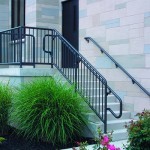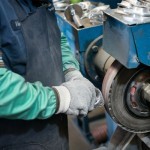The Complete Beginner’s Guide to Metal Railings
When it comes to railings, there are times when a simple wood railing will suffice but metal railings are an excellent solution for your home and business. Here are the basic things you need to know.
Material

You have several options when choosing which metal you would like to use for your metal railing—aluminum, brass, bronze, steel or stainless steel. The choice of material will vary based on your budget, product availability, interior vs. exterior, finish and structural requirements. You can view product options and costs at our e-commerce site.
Most people believe that stainless steel is the best solution for an exterior railing but this is not necessarily the case. Stainless steel railings, if not properly maintained, will show staining and signs of corrosion. An anodized, aluminum railing may be a better solution. Contact Wagner if you have a question as to what might work best in your application.
Understand the Building Codes and Standards
Building Codes have requirements for the size, strength requirements and height of metal railings. Also, make sure you confirm these requirements with your local authority having jurisdiction (AHJ) as they may have chosen to make their requirements more restrictive than what is included in the model codes.
Aesthetics
What are you looking for in terms of appearance and functionality? Do you want to maximize your view? Then glass railing or cable railing would be the way to go. Looking for post-mounted stainless steel? Consider our Legato™ Railing Collection. Utilitarian? Pipe Railing. Hospitality? Brass Railings.
Finish
There are three categories of metal finishing—mechanical, chemical or organic.

Mechanical finishes refer to those finishes utilizing an abrasive. The most common finishes are a satin finish or a bright polished finish. While visual appearance is the main selection criterion, different mechanical finishes will perform better than others depending on the environment. For instance, a satin finish creates more surface area and permits dirt and contaminants to settle into troughs in the surface. These contaminants could cause stainless steel to corrode if not cleaned out. A bright, polished finish will not retain these contaminants but will show fingerprints.
Chemical finishes refer to chemical “agers” or anodized finishes.
In some installations, the preferred finish may be to create a rusted (steel) or antique finish (brass or bronze). While this finish can be achieved over time by leaving the material unfinished, the preference is to accelerate that aging chemically and then seal the surface with wax or a clear coat.
Most people don’t realize that aluminum is subject to oxidization if left unfinished. Aluminum can be treated with a chemical process known as anodizing which seals the surface as well as adds additional hardness to protect the aluminum from scratches.
Organic finishes refer to wax or paint. Steel and aluminum are good metals to use when you want to introduce a color to your metal railing.
Wax is recommended for brass or bronze railings as they do need some type of sealant (unless your goal is an antique finish) to keep the material from tarnishing. While this can be done with a clear coat, we tend to suggest a wax finish for the handrail. Clear coat finishes are subject to wear and/or chipping. With brass, if an area wears away and is exposed, that area will start to tarnish. This requires the finish to be stripped, the material cleaned, and a reapplication of a clear coat. With wax, if an area wears down to bare metal and begins to tarnish, you would need to clean off the tarnish and apply a new coat of wax.
Do not assume that any of these finishes excuse you from maintenance. When installing metal railings, make a habit of regular inspections and cleaning to maintain your railings.
